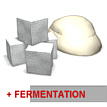
More than 100 different monomers can be combined within this family to give materials with extremely different properties.
They can be either thermoplastic or elastomeric materials, with melting-points ranging from 40 to 180°C.
The most common type of PHAs is PHB (poly-beta-hydroxybutyrate). PHB has properties similar to those of PP, however it is stiffer and more brittle.
A PHB copolymer called PHBV (polyhydroxybutyrate-valerate) is less stiff and tougher, and it is used as packaging material.
Category
Products
Razor, biodegradable (PHA)
Shampoo bottle, biodegradable (PHBV)
Surgical sutures
Processes
Injection moulding
Extrusion
Keywords
PHBV
References
Monsanto Company (BiopolTM)
PHB production
Price
Prices are thus falling down (1993: 100-140 DKK/kg) and, in a couple of years they could reach a level which would enable mass-production (2-6 DKK/kg).
Environmen- tal notes
Use: It is biocompatible and therefore can be implanted in the body without causing inflammations.
The producer claims that is not toxic.
Disposal: It biodegrades in microbially active environments in 5-6 weeks.
The action of some enzymes produced by microbs solubilises PHB which is then absorbed through the cell wall and metabolised.
PHB is normally broken down to carbon dioxide and water when degraded in aerobic conditions. In absence of oxygen the degradation is faster, and methane is also produced.
PHB is not degraded in biologically inactive systems such as sanitary landfills.
Photo
Copyright
This page is part of Design inSite
Disclaimer